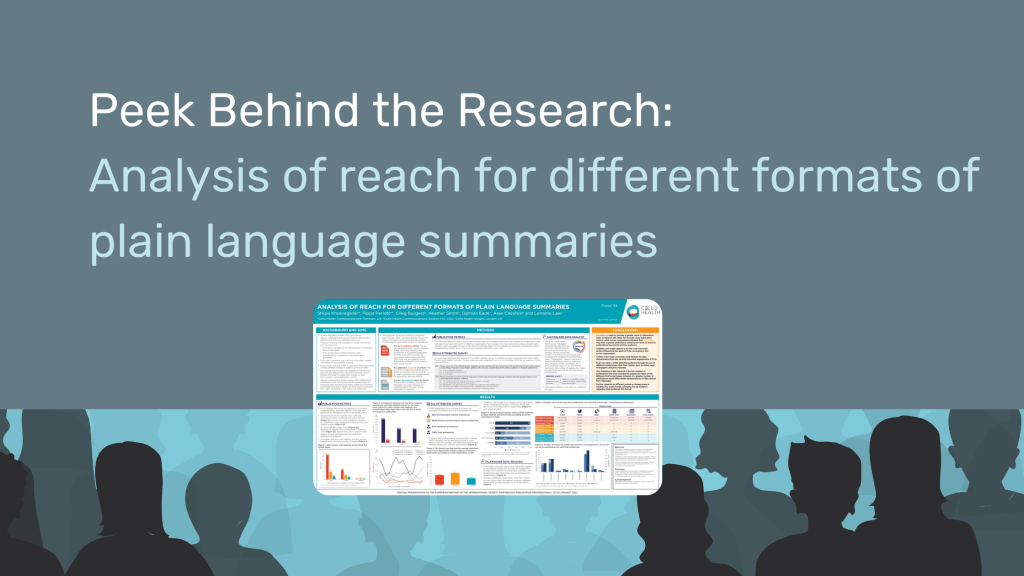- Written by Joanne Walker
Peek Behind the Research: Analysis of reach for different formats of plain language summaries
Continuing our ‘Peek Behind the Research’ interview series from the 2022 European Meeting of the International Society for Medical Publication Professionals (ISMPP) , learn more about the poster ‘Analysis of reach for different formats of plain language summaries‘. Here Shilpa Khobragade (Principal Medical Writer, Lumanity*), Pippa Perrett (Medical Writer, Lumanity) and Lorraine Law (Associate Editorial Director, Lumanity) talk us through their research and their thoughts on PLS.
Read our interview in full below or access the poster here.
ISMPP-EU-2022-Analysis-of-reach-for-different-formats-of-plain-language-summaries
Source: ‘Analysis of reach for different formats of plain language summaries‘ originally presented at the 2022 European Meeting of ISMPP, January 2022.

Why did you carry out this research?
Acknowledgment of the importance of plain language summaries (PLS) is growing, with recognition of their potential ability to increase the reach, visibility, and impact of publications. Despite the rising interest in PLS, there is currently a limited understanding of their potential reach. Our work aimed to understand the potential reach of three different PLS formats: standalones, those published alongside articles, and lay abstracts.
What were the main findings?
From this research, we had four key findings.
- Standalone articles provide a greater reach of information than either PLSs published alongside or lay abstracts, according to publication metrics.
- From our survey of industry professionals, it appeared that PLS published alongside articles may have a greater potential to enhance the reach of a publication beyond the primary audience.
- Again from our survey – it was suggested that PLS citability and length are likely to be the main factors influencing their reach.
- We found that PLS can reach a wider potential audience using different media types other than Twitter, such as online news, newspapers and press releases.
Were you surprised by any of the results?
Several findings surprised us, including:
- The difference between the highest Altmetric attention scores (AAS) and the survey results for most impactful PLS type in terms of reach – we found that standalone articles had the greatest AAS and greatest number of tweets, while our survey results suggested PLSs published alongside articles to be the most impactful.
- According to industry professionals who took part in our survey, citability was suggested to be the highest influencing factor for reach, with readability being the lowest.
- Publication of the PLS we investigated did not appear to impact the number of page views subsequently received by the corresponding main article.
Are you looking to continue this research further?
We aim to continue our investigations into the reach of different PLS formats, as we have only just begun to scratch the surface. Our next step will be surveying the lay audience to discover which PLS format is most likely to enhance – and which PLS attributes they feel best increases – the potential reach of a publication beyond the primary audience. These results will show how closely lay audience responses correspond with industry professional responses, and with publication metrics.
Finally, what are your thoughts on the future of PLS and their place in medical/scientific research?
Pippa: I feel with appropriate methods of making PLS discoverable, whether through a central repository or inclusion of appropriate links to the start of the manuscripts, PLS will help various readers, from non-expert health care professionals to patients, keep up to date with the latest research.
Lorraine: I think PLSs are a valuable tool for demystifying scientific research, particularly when tackling the vexing question of communicating a drug’s effectiveness and safety, the clinical significance of results and patient benefit. The coronavirus pandemic has shown how open accessibility of scientific data on the internet – when it was previously hidden behind university library walls – and the leverage of news and social media have made it possible for misinformation to spread easily, because the vast majority of research communication relies on expert interpretation of risk and benefit. PLS can play a role in helping patients and the public in general understand the principles and underlying significance of medical research, and what it really means for them.
Shilpa: I think PLS are important tools and have a great future. But I believe the authors who publish the original article together with the writers with PLS expertise should guard against any misunderstanding in the lay audience. I also feel that the PLS are very helpful for not only the patients, caregivers, or lay audience but also for the non-specialist professionals. I believe from the patient’s perspective; readability is an important factor but the PLS should not be oversimplified or ‘dumbed down’ too much as they are probably exposed to other scientific and complex materials and might find it insulting or not scientifically robust. In a nutshell, the PLS should be written to cater for a wide variety of audiences at an appropriate readability level and to achieve this, the PLS writers should be properly trained.
Acknowledgements: The authors would like to thank their co-authors Craig Burgess, Heather Smith, Aree Cheshire and Damian Eade from Lumanity for their work on this research project.
*Formerly Cello Health Communications/Cello Health Insight
